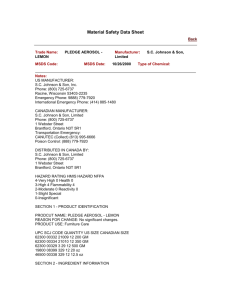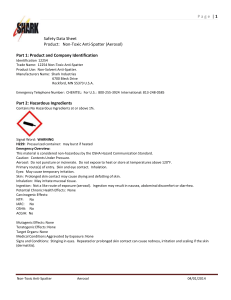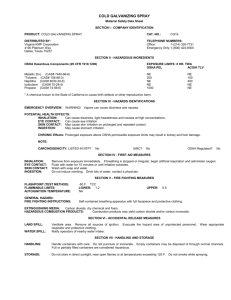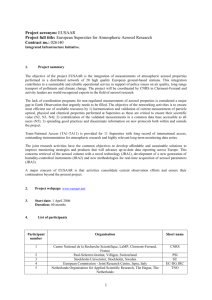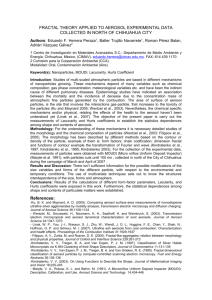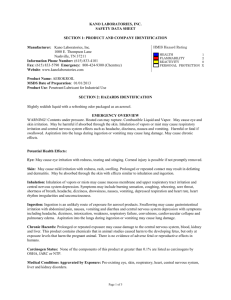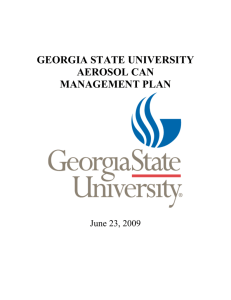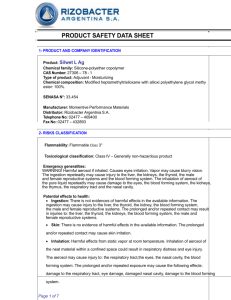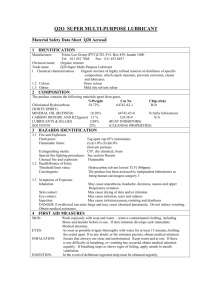STATEMENT OF HAZARDOUS NATURE:
advertisement
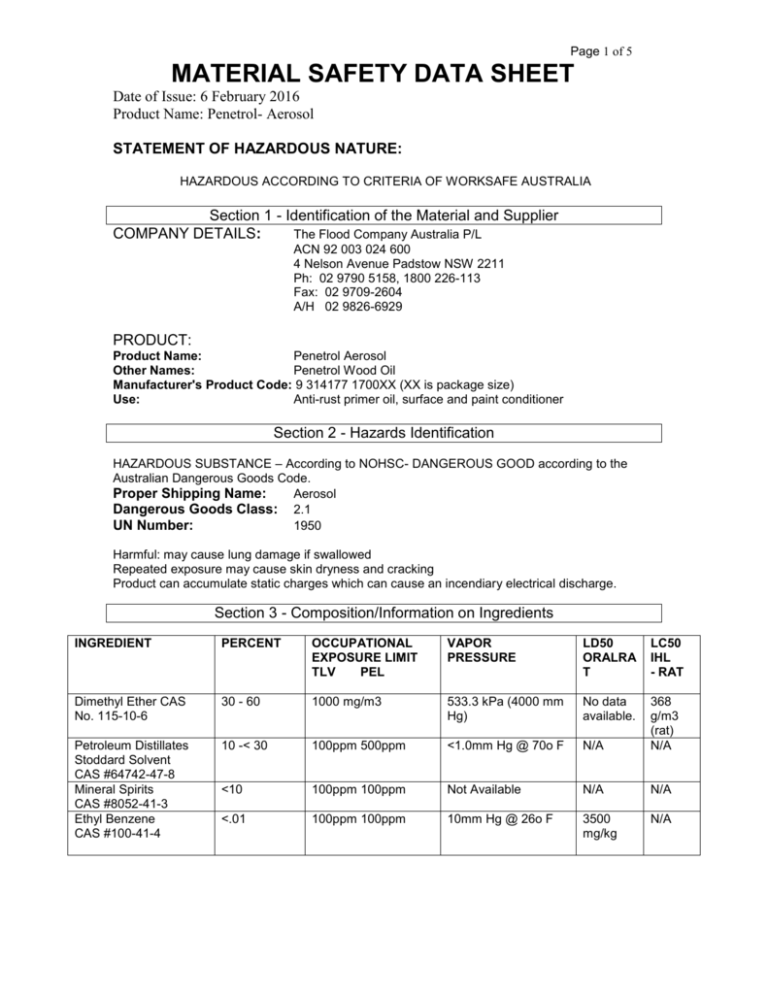
Page 1 of 5 MATERIAL SAFETY DATA SHEET Date of Issue: 6 February 2016 Product Name: Penetrol- Aerosol STATEMENT OF HAZARDOUS NATURE: HAZARDOUS ACCORDING TO CRITERIA OF WORKSAFE AUSTRALIA Section 1 - Identification of the Material and Supplier COMPANY DETAILS: The Flood Company Australia P/L ACN 92 003 024 600 4 Nelson Avenue Padstow NSW 2211 Ph: 02 9790 5158, 1800 226-113 Fax: 02 9709-2604 A/H 02 9826-6929 PRODUCT: Product Name: Penetrol Aerosol Other Names: Penetrol Wood Oil Manufacturer's Product Code: 9 314177 1700XX (XX is package size) Use: Anti-rust primer oil, surface and paint conditioner Section 2 - Hazards Identification HAZARDOUS SUBSTANCE – According to NOHSC- DANGEROUS GOOD according to the Australian Dangerous Goods Code. Proper Shipping Name: Aerosol Dangerous Goods Class: 2.1 UN Number: 1950 Harmful: may cause lung damage if swallowed Repeated exposure may cause skin dryness and cracking Product can accumulate static charges which can cause an incendiary electrical discharge. Section 3 - Composition/Information on Ingredients INGREDIENT PERCENT OCCUPATIONAL EXPOSURE LIMIT TLV PEL VAPOR PRESSURE LD50 ORALRA T LC50 IHL - RAT Dimethyl Ether CAS No. 115-10-6 30 - 60 1000 mg/m3 533.3 kPa (4000 mm Hg) No data available. Petroleum Distillates Stoddard Solvent CAS #64742-47-8 Mineral Spirits CAS #8052-41-3 Ethyl Benzene CAS #100-41-4 10 -< 30 100ppm 500ppm <1.0mm Hg @ 70o F N/A 368 g/m3 (rat) N/A <10 100ppm 100ppm Not Available N/A N/A <.01 100ppm 100ppm 10mm Hg @ 26o F 3500 mg/kg N/A Page 2 of 5 MATERIAL SAFETY DATA SHEET Date of Issue: 6 February 2016 Product Name: Penetrol- Aerosol Section 4 First Aid Measures EXPOSURE LIMITS No exposure standards have been established for this material. Exposure standards recommended by Worksafe Australia for some ingredients are as follows: SKIN: Wash affected area with soap and water, flush with large amounts of water. If irritation persists, get medical attention. Do not continue to wear oil-soaked clothing. Discard oil-soaked leather goods. Wash contaminated clothing before reuse. EYE: Flush immediately with large amounts of water for at least 15 minutes while holding eyelids open. Get medical attention. INHALATION: Remove victim to fresh air. Seek medical attention if symptoms persist. SWALLOWING: Rinse mouths, then drink 1 or 2 large glasses of water, DO NOT INDUCE VOMITING due to danger of aspirating oil into lungs. If vomiting occurs spontaneously, keep head below hips to prevent breathing of liquid into the lungs. DO NOT give anything by mouth if the person is unconscious or having convulsions. Get medical attention immediately. NOTE TO PHYSICIAN: Aspiration of liquid petroleum products into lungs may cause severe pneumonitis (oil pneumonia). Vomiting should not be induced. Treat symptomatically Section 5 Fire Fighting Measures EXTINGUISHING MEDIA: ( X ) FOAM ( X ) CO2 ( X ) DRY CHEMICAL (X) WATER FOG UPPER UNUSUAL FIRE AND EXPLOSION HAZARDS: Flammable gas. Exposure of closed containers to heat can cause disruptive pressure. Vapors are heavier than air and may travel along the ground or be moved by ventilation and ignited by heat, pilot lights, other flames and ignition sources at locations distant from material handling point. Do not flush into public sewer system. SPECIAL FIREFIGHTING PROCEDURES: Avoid breathing fumes. Wear adequate respiratory protection. Water may be ineffective as extinguishing medium but may be used to cool closed containers exposed to heat. Respiratory protection should be self-contained, breathing apparatus type with a full face piece operated in a pressure demand or other positive pressure mode. Section 6 Accidental Release Measures STEPS TO BE TAKEN IN CASE MATERIAL IS RELEASED OR SPILLED: Remove all sources of vapor ignitions. Ventilate area. Stop spill at source. SMALL SPILL: Remove liquid waste with oil-absorbing compounds and non-sparking tools. LARGE SPILL: Exclude persons not wearing protective equipment, dike area of spill and pump liquid into salvage tank. Section 7 Handling and Storage Explosion Hazard: Flammable. Container may rocket or explode in heat or fire. Page 3 of 5 MATERIAL SAFETY DATA SHEET Date of Issue: 6 February 2016 Product Name: Penetrol- Aerosol PRECAUTIONS TO BE TAKEN IN HANDLING AND STORING: Avoid heat, sparks, flame, or smoking during use. Do not crush, puncture or incinerate. Avoid extreme heat and ignition sources. Avoid spraying toward open flame. Avoid puncturing or otherwise damaging aerosol containers and packaging when using forklifts or other material handling equipment. OTHER PRECAUTIONS: Protect from sunlight and do not expose to temperatures exceeding 120oF (50oC). Keep from extreme cold. Store Pressurized container in accordance with local requirements for Aerosol in well ventilated, cool area. Store away from oxidizers. DANGER: Rags, steel wool or waste soaked with this product may spontaneously catch fire if improperly discarded. Immediately after use, place rags, steel wool or waste in a sealed water filled metal container to prevent this. High pressure gas. Gas may cause flash fire. Gas reduces oxygen available for breathing. Section 8 Exposure Controls/Personal Protection RESPIRATORY PROTECTION: If TLV of the product or any component is exceeded, a NIOSH/OSHA jointly approved, air supplied respirator is advised in absence of proper environmental control. OSHA regulations also permit other NIOSH/OSHA respirators under specified conditions (see your safety equipment supplier). Engineering or administrative controls should be implemented to reduce exposure. VENTILATION: Provide sufficient mechanical (general and/or local exhaust) ventilation to maintain exposure below TLV(s). PROTECTIVE GLOVES: Oil resistant if prolonged contact is likely. EYE PROTECTION: Goggles with side shields when spraying or where splashing is likely. OTHER PROTECTIVE EQUIPMENT: Oil repellent, protective clothing if prolonged contact is likely. HYGIENIC PRACTICES: Wash hands with soap and water before eating, drinking, smoking, or using toilet facilities. Launder contaminated clothing before reuse. Section 9 Physical and Chemical Properties Volatile Volume: Physical State: Appearance & Odor: Odor Threshold: Freezing Point: Ph: Vapour Pressure: Viscosity: Solubility in Water: 70% Aerosol Clear Amber, Mild Solvent and chloroform Odor Not Available Not Applicable Not Applicable <0.1kPa at 20C >7 mm2/s at 40ºC Insoluble Flashpoint: [ Dimethyl Ether] Flammability Limits: Lower Flammable Limit: Closed cup: -41.15°C (-42.1°F) [Pensky-Martens.] Not Available Not Available Page 4 of 5 MATERIAL SAFETY DATA SHEET Date of Issue: 6 February 2016 Product Name: Penetrol- Aerosol Section 10 Stability and Reactivity Hazardous Polymerisation: Will not occur STABILITY: ( X ) STABLE HAZARDOUS POLYMERIZATION: ( X ) WILL NOT OCCUR HAZARDOUS DECOMPOSITION PRODUCTS: Combustion in restricted environments can produce carbon monoxide, carbon dioxide and various hydrocarbons. CONDITIONS TO AVOID: Storage of combustible materials wetted with liquid can produce heat and spontaneous combustion. INCOMPATIBILITY (MATERIALS TO AVOID): Stable under normal conditions of use. Avoid contact with strong oxidizers. Section 11 Toxicological Information EFFECTS OF OVEREXPOSURE: SKIN: May cause skin irritation. Prolonged or repeated contact can result in defatting and drying of the skin which may result in dermatitis. EYE: May cause eye irritation. Symptoms include stinging, tearing, redness. INHALATION: Vapors may cause narcosis and irritation of respiratory system. Prolonged or repeated contact can cause nasal and respiratory irritation, an irregular heartbeat, dizziness, weakness, fatigue, nausea, headache, an irregular heartbeat, narcosis, possible unconsciousness, and even asphyxiation. SWALLOWING: Can cause gastrointestinal irritation, vomiting. Aspiration (breathing) of vomitus into lungs must be avoided; can enter lungs and cause severe damage. Harmful or fatal if swallowed. None of the ingredients of this mixture are listed as a carcinogen or potential carcinogen by the National Toxicology Program (NTP), International Agency for Research on Cancer (IARC), or the Occupational Safety and Health Administration (OSHA). MEDICAL CONDITIONS PRONE TO AGGRAVATION BY EXPOSURE: Preexisting eye, skin, and respiratory disorders may be aggravated by exposure to this product. PRIMARY ROUTE (S) OF ENTRY: ( X ) DERMAL ( X ) INHALATION ( X ) INGESTION ( X ) EYE Section 12 Ecological Information Acute Toxicity Fish : Harmful: 10 < LC/EC/IC50 <= 100 mg/l Aquatic Invertebrates : Harmful: 10 < LC/EC/IC50 <= 100 mg/l Algae : Toxic: 1 < LC/EC/IC50 <= 10 mg/l Microorganisms : Expected to be harmful: 10 < LC/EC/IC50 <= 100 mg/l Mobility : Floats on water. Persistence/degradability : Readily biodegradable (hydro treated petroleum) Oxidises rapidly by photo-chemical reactions in air. Bioaccumulation : Has the potential to bioaccumulate. The volatile component will rapidly evaporate to the air if released into the water. May be toxic to aquatic organisms. Environmental protection: Do not allow to enter drains, waterways or sewers Page 5 of 5 MATERIAL SAFETY DATA SHEET Date of Issue: 6 February 2016 Product Name: Penetrol- Aerosol Section 13 Disposal Considerations Do not incinerate closed containers. Do not dispose of waste material in sewers or waterways. Promptly incinerate wetted, combustible, oil-absorbing materials. Dispose in accordance with all local, State and Federal regulations. Section 14 Transport Information This product is not a dangerous good for transport UN Number: Not applicable UN Proper Shipping Name. Not applicable Class and subsidiary risk(s): Not applicable Hazchem Code: Not applicable Section 15 Regulatory Information UN Number: 1950 Dangerous Goods Class and Subsidiary Risk: 2.1 Aerosol according to the Australian Dangerous Goods Code Hazchem Code: 2[Y] E Poisons Schedule Number: Not applicable US SECTION 313 - SUPPLIER NOTIFICATION This product contains the following toxic chemicals subject to the reporting requirements of Section 313 of the Emergency Planning and Community Right-To-Know Act of 1986 and 40 CFR 372: CAS# Chemical Name % by Weight - 100-41-4 Ethyl Benzene <0.1 Section 16 Other Information Keep out of reach of children. The above information is believed to be correct with respect to the formula used in manufacture of the product. As data, standards and regulations change, and conditions of use and handling are beyond our control. NO WARRANTY. EXPRESSED OR IMPLIED, IS MADE AS TO THE COMPLETENESS OR CONTINUING ACCURACY OF THE INFORMATION
